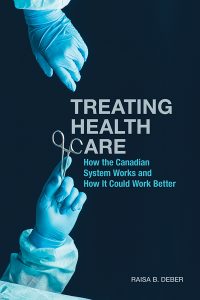When they wrote the Constitution in 1867 life expectancy was 42, few cures for disease were known, and a physician’s practice was comprised mainly of delivering babies and amputating limbs. Health care was so cheap and uncomplicated the Fathers of Confederation left it to the provinces, and assigned the really heavy lifting to Parliament – like regulation of railways and canals.
“The provisions of the Constitution were based on the realities of life in 1867,” writes Prof. Raisa Deber; “Things were designated as national responsibilities because they were expensive or because they were important to nation building.”
“Although few realized it at the time, these provisions have proven critical in determining who would have responsibility for health care in Canada,” writes Deber. Here we are, 154 years later, with a medicare system many Canadians rate as mediocre outside of treating babies and broken limbs. “We still look very good compared with the United States, but so does everyone else,” notes Deber, of the University of Toronto’s Institute of Health Policy.
Treating Health Care: How the Canadian System Works and How It Could Work Better is frankly excellent. Prof. Deber has a crisp, engaging writing style that strips away the adjectives and political hyperbole that muddles so much of the medicare debate. “As an experienced teacher of health policy, my philosophy has always been that it is not my job to tell you what you should want, but it is my job to tell you whether a particular approach is likely to take you where you want to go,” writes Deber.
Parliament since 1957 has transferred grants to provinces to run the hospitals. Federal funding used to cover 50¢ on the medicare dollar. The original Hospital Insurance And Diagnostics Services Act allowed health taxes or user fees; Saskatchewan charged patients $35, the equivalent of $260 today. “If you give people a card from Santa Claus entitling them to free hospital services, it’s not good psychology,” as then-Premier Tommy Douglas put it. “But the amount should be sufficiently small that it doesn’t impose financial burdens on anybody.”
Today Ottawa pays about 23¢ of every pre-pandemic health care dollar, and there is no proof a $260 user fee would make any difference whatsoever. “The evidence is clear that user fees indeed discourage people from seeking care, but this effect is not very sensitive to whether that care is necessary,” writes Deber. Treating Health Care notes one in five Canadians cannot afford necessary prescription drugs, with resulting costs borne by ratepayers when patients are rushed to hospital with strokes or other emergencies made worse by their inability to buy medication.
“People need the right care, at the right time, at the right place, at the right price,” writes Deber. “Fortunately, most of the time, that is what we get, particularly when we are really sick. But that depends heavily on who we are, where we live, what health problems we have, and which providers we are seeing. This implies that most reforms will tend to be incremental.”
Treating Health Care is a good start.
By Holly Doan
Treating Health Care: How the Canadian System Works and How It Could Work Better, by Raisa B. Deber; University of Toronto Press; 224 pages; ISBN 9781-4875-21493; $24.95






